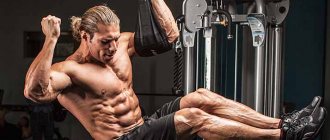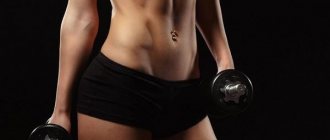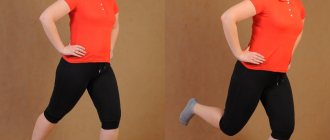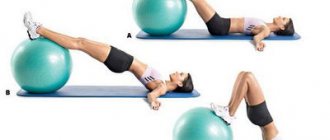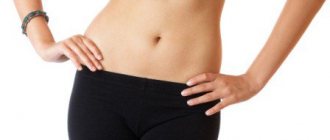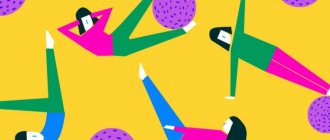Abdominal stretch with emphasis on the forearms
What muscles are we stretching: rectus abdominis muscle.
Performance. Lie on your stomach and lift your chest, resting on your elbows. As you perform this exercise, you should feel a slight stretch in your abdominal area.
A comment. The rectus abdominis usually doesn't require much stretching, so doing this exercise a few times a week after your ab workout will do the trick.
Abs stretch
Stretching for the abdominal area will be appropriate in any program that affects this muscle group. Strengthening your abs is useful not only for the beauty of your figure, but also for improving blood circulation. Through the bloodstream, muscle cells receive nutrients and oxygen; with increased nutrition, the muscular system tolerates training more easily and recovers faster after it.
During stretching, the muscles relax. Intense training without adding stretching leads to adhesions - these are scar formations on the walls of the abdominal cavity. Once an adhesion appears, it will not be possible to get rid of it without myofascial release or other specialized techniques. It will be much easier to carry out prevention than to eliminate the problem that has arisen.
Listed below are the most effective exercises for stretching the abdominal muscles; they do not require special equipment. To increase flexibility and mobility of the body, improve overall fitness, perform this complex at least three times a week.
Standing abdominal stretch
What muscles are we stretching: rectus abdominis muscle.
Performance. Stand with your back to any support, feet resting on the floor at the base. Raise your arms above your head, grasp the support and, without lifting your feet from the floor, bend forward slightly.
A comment. This exercise carefully and efficiently stretches not only the abdominal muscle group, but also other equally important ones: the latissimus dorsi and triceps. While stretching, remember to keep your body relaxed.
Stretching the abdominal muscles while lying on your back
Exercise No. 6
Lie on your back, stretch your arms along the floor above your head, and pull your socks towards you. Stretch this way: stretch your fingers up, and your heels in the opposite direction (down). At the same time, pull in your stomach, do not bend at the lower back, breathe evenly. Hold the stretched position for 15 seconds. Do several approaches.
Video abdominal stretching from personal trainer Brian Francis
Exercise No. 7
Take a lying position on your back, spread your arms to the sides, bend your legs at the knee joint and place them on your right side. Smoothly move your legs from right to left and vice versa. Don't take your hands off the floor. Perform 10 turns on each side.
Video stretching the abdominal muscles Avon Fitness Challenge
Exercise No. 8
Take a position supporting your hands while lying on your back: bend your legs at the knees, rest your palms on the floor. Raise your body up until your abdominal muscles are stretched comfortably. At the highest point, hold for 15 seconds. Repeat the rectus abdominis stretch several times.
During exercises to stretch the abdominal muscles, do not make sudden movements, do not bend too much in the lower back and come out of the poses slowly, without jerking. For maximum effectiveness, perform the complex regularly.
Source
Side stretch while lying down
What muscles are we stretching: obliques, latissimus dorsi, quadratus lumbar muscles.
Performance. Lie on your back with one side pressed against a wall or any other support, and stretch your arms behind your head. Then begin to pull your upper body in the opposite direction. At the same time, the legs and hips should not come off the wall.
A comment. Placing your hands behind your head engages the latissimus dorsi and teres major muscles. They pull the arm back and down, bringing it towards the body (adduction), and also rotate it inward (pronation). If your arms remain extended along your body, only your abdominal muscles will be stretched.
Side stretch in pairs
What muscles are we stretching: obliques, latissimus dorsi, quadratus lumbar muscles.
Performance. Stand with your partner side to side at a distance of about one step, feet together. Grasp each other's forearms on the inside, raise your hands on the outside and clasp your palms together, forming an arch. From this position, gently bend away from your partner, stretching the outer side of your body. The legs should not leave the floor or change position.
A comment. It is advisable that you do not differ much from each other in height and weight, otherwise the exercise will not be very convenient and effective. The main goal is to stretch the entire side, including the glutes, obliques, and latissimus dorsi.
Static stretching. Exercises for the abdominal muscles (for the abdominal muscles).
Exercise 1.
Take the starting position: stand straight, feet shoulder-width apart, knees slightly bent, feet turned outward, arms in a free position. From the starting position, raise your right arm up, rest your left hand on your thigh. Tilt your torso to the left with the maximum amplitude possible for you. Feel the stretch in your obliques and hold this position for 30 seconds.
Relax and return to the starting position. Perform the exercise in the other direction.
Important points: maintaining a straight back position, tilt the body strictly to the side, without falling back or leaning forward; maintain a straight position with your arm extended upward; the raised arm should always remain in the same plane with the body, the palm of the hand is directed only downwards, towards the floor; breathe evenly.
Exercise 2.
Take the starting position: stand straight, feet shoulder-width apart, knees slightly bent, feet turned outward, right arm lowered along the body, left arm bent at the elbow and placed on the back of the head. From the starting position, bend your torso to the right with the maximum possible amplitude. Feel the stretch in your obliques and hold this position for 30 seconds. Relax and return to the starting position. Perform the exercise in the other direction.
Important points: when bending, keep your back straight, try not to lean your body back or lean forward; the arm bent at the elbow should always remain in the same plane with the body; breathe evenly.
Exercise 3.
Take the starting position: stand straight, feet shoulder-width apart, knees slightly bent, feet turned outward, right arm raised straight up, left arm bent at the elbow and clasping the right forearm. From this position, maintaining the original position of your arms, tilt your torso to the left with the maximum amplitude possible for you. Feel the stretch in your obliques and hold this position for 30 seconds. Relax, lower your arms down and slowly return to the starting position. Perform the exercise in the other direction.
Important points: when bending, keep your back straight, trying not to lean your body back or tilt it forward; the position of the hands while bending should always remain in the same plane with the body; to enhance the amplitude, you can lightly press with your bent arm on the forearm of your outstretched arm; breathe evenly.
Exercise 4.
Take the starting position: lying on your stomach, resting on your forearms, your back and shoulders relaxed. From the starting position, lift your chin, connect your shoulder blades and stretch upward, slightly straightening your arms. Feel the stretch in your abdominal muscles and hold this position for 30 seconds. Relax and slowly return to the starting position.
Important points: try not to lift your hips off the floor; do not throw your head back; to increase the stretching amplitude, you can fully straighten your arms at the elbows; breathe evenly.
"Cat"
What muscles are we stretching: the rectus abdominis muscle, a group of straightening muscles of the back.
Performance. Get on all fours, focusing on straight arms and knees. Pull your stomach in so that your back arches upward. In this position, relax and press your torso down, creating a reverse arch in your spine. Then take a deep breath, stretch your stomach and, as you exhale slowly, tighten your abdominal muscles.
A comment. This exercise has a positive effect on the mobility of the spine and the small muscles surrounding it. It is also worth paying attention to the importance of stretching the spinal column, especially in the lumbar region.
"Boat"
What muscles are we stretching: gluteus medius and maximus, iliocostal muscles.
Performance. Lie on your back, bend your knees and pull them as high as possible (almost to your chin), clasping them with your arms. The spine should form a slight arch, and there should be no feeling of discomfort in the cervical region. Relax and stay in this position.
A comment. This exercise makes your spine and surrounding muscles more mobile and removes tension. Especially useful for the lumbar region.
Spinal twists with the help of a partner
What muscles are we stretching: oblique abdominal muscles.
Performance. Sit on a flat bench, back straight, bodybar (or bar) resting on your shoulders, you hold on to it at both ends (arms as wide as possible). Your partner stands behind you, grabs the bodybar in the same places where your hands are, and gently turns you to the side until you feel a stretch in the oblique abdominal muscles. Then return to the starting position, inhale and exhale and repeat the twist, but in the other direction.
A comment. Due to the tension in the rotator cuff muscles, this exercise cannot be performed correctly without assistance. To get the greatest effect, you should relax your abdominal muscles and exhale as you twist to the side.
To do this stretch on your own, place your hands behind your head and twist yourself from side to side. This can be done even while sitting at your desk.
Stretching the lateral abdominal muscles in a sitting position
Exercise No. 3
Sit on a chair, place your hands behind your head and clasp your fingers. Keep your back straight, do not point your elbows forward and lean alternately to the right and left. At the point of maximum tension in the abdominal muscles, hold for 10 seconds. Do several approaches. For the greatest effect, press your buttocks firmly into the chair and do not arch your back. To make the exercise easier, you can place your feet behind the legs of the chair. This way we stretch the external and internal obliques and rotator cuff muscles.
Exercise No. 4
Sit cross-legged with your legs crossed in front of you. Place one hand on your knee and lift the other up. Reach towards the opposite side of your raised arm. At the lowest point, when you feel maximum abdominal tension, hold for 15 seconds. Then switch sides. Do several approaches. Remember to have a straight back!
Watch video - stretching the abdominal muscles
Side stretch on the floor
What muscles are we stretching: obliques, latissimus dorsi, quadratus lumbar muscles.
Performance. Sitting on your heels, move one leg to the side. In this position, begin to stretch your arm up and to the side until you feel a stretch in the side muscles. The second hand rests on the floor.
A comment. During this stretch, you should feel a stretch throughout the side of your body. If you don't feel anything, try moving your leg further to the side and extending your arm further, thereby increasing the resulting arc.
